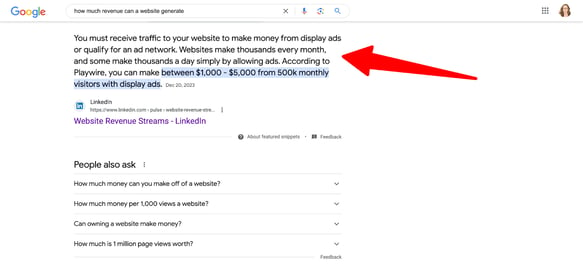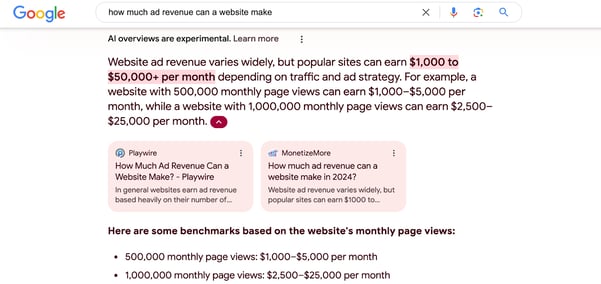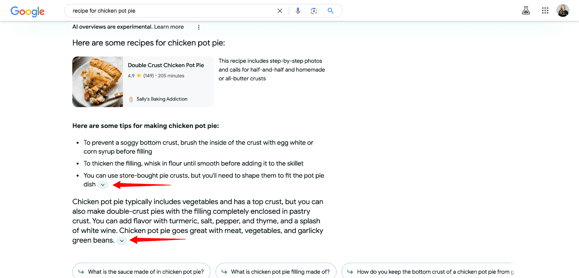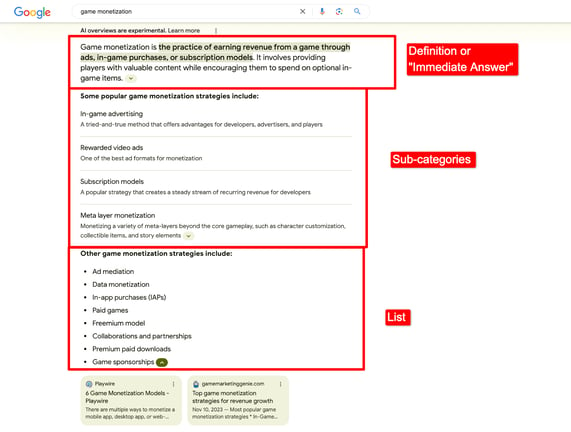How Google’s SGE Will Change the Face of Online Publishing
March 24, 2024
Editorial Policy
All of our content is generated by subject matter experts with years of ad tech experience and structured by writers and educators for ease of use and digestibility. Learn more about our rigorous interview, content production and review process here.

What is SGE?
SGE, or Search Generative Experience, is Google’s new interface for searchers that mimics more of a human-to-human, or conversational experience for searchers.
Per Google: “SGE is an early step in transforming the Search experience with generative AI. When using SGE, people will notice their search results page with familiar web results, organized in a new way to help them get more from a single search.”
The long and short of it is: that Google’s existing method for search will change to an experience that mimics the experience users have when interacting with AI tools that have become increasingly popular, like ChatGPT or Claude.AI.
The goal is to provide users with a deeper, more detailed answer to their questions directly from the search results. Contrast this with the historical goal of Google, which was to provide users with a list of pages that would best answer their questions when the user clicked through to the site.
The Complete Google Ad Manager Resource Center
The Evolution of Google’s Search Interface
To be clear, this isn’t necessarily a massive departure from the direction Google has been moving in for some time. Google has spent years rolling out features that were meant to help answer user questions directly in search results.
Calculators and Conversions
Way back in 2012, Google started adding calculators directly to search results so that users could complete calculations directly on Google instead of clicking through to a site that hosted or provided calculators.
Over time, they’ve continually rolled out more and more calculators to solve common questions, to support basic calculations and common conversions (e.g. inches to feet).
SERP Features
Starting in 2021, Google started building out its Search Engine Results Page (also known as SERP to SEO aficionados) features, providing what are commonly referred to as “Featured Snippets.”
Featured snippets would take chunks of content from website pages and display them directly on the search results page. The goal was to answer common questions quickly for users, without requiring the users to click through to the page itself unless they wanted more detail.

The goal was the same as that of SGE, to answer more questions for searchers with fewer clicks. Give an immediate answer to the query, and keep the user happy.
What Happened?
SERP Features rocked the content marketing and publishing world when they came out. Reminiscent of Y2K hysteria, many harkened to the “end” of SEO and feared the worst for websites that generated much of their traffic from organic search.
The fear, similar to the fears publishers have today regarding SGE, was that Google providing better answers in search results meant less click-through to the websites (and less revenue for those website owners).
What ended up happening was very different.
Everyone quickly learned that getting your answer featured in the featured snippet made you even more important. For searches that were deeper than “surface level” answers, getting yourself in the featured snippet became the coveted position (better than a #1 rank), and still resulted in plenty of click-throughs to your website.
Why is SGE Concerning Publishers?
Most publishers have the same fear as they did when SERP Features hit the scene: the more Google tries to answer directly in the search results, the less need a user will have to click through to your website.
Less visitors means less revenue (no matter if your revenue is derived from ads, affiliate links, or conversion).
So, how nervous should publishers be?
What Should Publishers Expect?
The answer to the question of how nervous you should be is entirely based on your content strategy.
The Scary Part
Frankly, the more surface-level your content, the more nervous you should be. Quite simply,if the majority of your content answers simple questions that don’t require users to want to learn more, the more likely they’ll be able to get an answer directly from “conversing” with SGE and forgo further click-through.
If you’re worried about this, I’d recommend making sure you build content that goes beyond answering simple questions and structure your content around simple questions to “promote” deeper exploration.
Similar to the way meta descriptions work, you should think of your answers to simple questions as the promotion or “ad” for why that user should want to delve deeper into the topic (making it more likely for them to click through to your site).
Take this example of one of our articles that earns a top spot in SGE’s response to the query “How much ad revenue can a website make?”

The query itself is a simple question, potentially looking for a simple answer. But in our content, we’ve made sure to structure our wording to clarify that it is not a simple answer and that many factors make website revenue highly variable.
This information, packaged next to the “simple” answer makes it clear that the user should click through to the site for more information. When writing our content, we are treating our “simple answer” wording as if it were an advertisement convincing a reader why they should read more.
The Exciting Part
However, I’d encourage publishers to look at SGE just the way they looked at SERP rankings. Rather than scary, they can be a useful tool that you just need to figure out how to use.
The beauty of SGE is that it is like SERP Features on steroids. It somewhat “democratizes” SERP results, providing the user a lot more in terms of potential answers to their questions. And it does it from a much larger variety of sources. In the screenshot below, every arrow that points downward expands to show several sites from which the AI response derived their answer.

It essentially combines many sources to provide a SERP Feature and then shows all the sources, making it much more likely that you’ll be able to get featured directly in the response.
At the end of the day, as the user, I still will click through to one of the many sites I have presented to me from the SGE results to follow a step-by-step recipe to make chicken pot pie for my needs to be served.
How to Make the Most of SGE
The best way to make the most of SGE is to structure your content in ways that make it easy for AI algorithms to parse and ultimately grab useful chunks of information to put into their responses.
The nice part about SGE is that it offers more opportunities than just a single SERP listing to potentially get featured.
There are a few ways that SGE tends to like putting results together that are common or repeatable.

- Definitions: SGE will try to extract definitions from web content to provide a summarized description of a term to users.
- Immediate Answer: If the user is posing a question, SGE will try to find the most complete and direct answer to present them with.
- Sub-Categories: If, like the example shown in the graphic, there are multiple answers to a question, it will try to break it up into sub-categories and give information on each.
- Lists: SGE also likes to provide summarized lists to users to allow them to think through options, making it easier for them to pose follow-up questions to SGE for deeper dives.
Each one of these responses within the AI “conversation” presents opportunities for your content to contribute to SGE’s answer. And anytime your content contributes to an answer, the user can choose to click through to your site for more details.
Tips for Content Structure
If you really want to get down into the weeds, there are some hyper-specific tricks you can use to structure your content in ways that make it more likely for SGE to use your content in its responses.
- Definitions: Anytime you are writing about something that might be a definition, make sure to call out and include the definition in your content. Set those definitions as a block quote to help them stand out from the rest of the content.
- Answer a Question: If you are answering a search question, specifically answer the question in a 2-3 sentence paragraph (and use the strategy mentioned above to promote deeper inquiry into the topic). Make sure the answer goes immediately under the question, with the question structured as a sub-title. Pull all of it out into a block quote to help it stand out from the rest of the content.
- Lists: Whenever possible structure answers to questions as a list if there are multiple answers. If your content addresses each answer, make sure you create a table of contents at the top of the article and use anchor links down to sub-sections.
Final Thoughts
SGE, while it is a big step forward, is just an extension of what Google has been doing for years with calculators and featured snippets.
If you are creating content that is beyond surface level and focuses on providing real value to the user, you’ll be fine. And, you can definitely structure your content to increase your chances of getting SGE to treat you positively.
Interested in learning more? Reach out to the experts at Playwire for more information.

-1.png?width=800&height=157&name=1-playwire-logo-primary-2021%20(1)-1.png)




